How to Cook Tortellini: A Complete Guide with Tips, Tricks, & Recipes
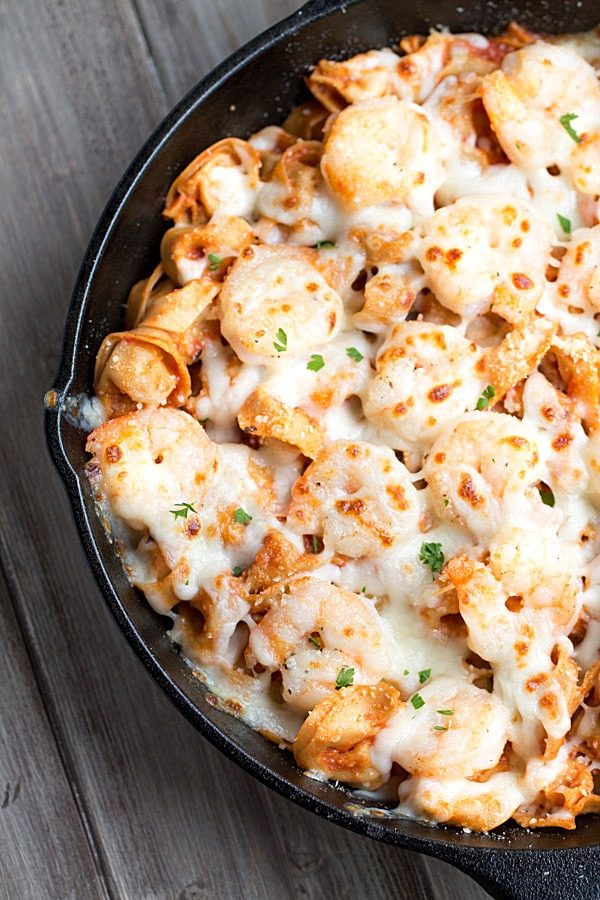
Tortellini is one of those pantry staples I always keep on hand for nights when I need dinner fast but still want something warm, filling, and downright comforting.
I first started cooking tortellini in my early twenties, back when I thought “pasta night” meant boiling spaghetti and pouring on some jarred sauce. One day I spotted a pack of Buitoni tortellini in the grocery fridge section and thought, well, that looks fancy. I tossed it with butter and Parmesan that night, and y’all, it was love at first bite. Over the years, I learned how to get it just right, no mushy noodles, no bland filling, and no more floating mystery about whether it was done or not.
These days, I cook tortellini a few different ways depending on what I’ve got in the fridge and who I’m feeding. From creamy soups to skillet bakes, it’s become my go-to shortcut for making a meal feel a little more special without much fuss. And let me tell you, it’s one of the easiest pastas you can cook, even if you’re brand new in the kitchen.
In this post, I’m breaking down everything you need to know: what tortellini actually is, how to cook it right (fresh or frozen), and how to avoid the most common mistakes that trip folks up. I’ll walk you through an easy base recipe, answer all those Googled questions about store-bought tortellini, and share a few of my favorite tortellini recipes for when you’re ready to branch out.
If you’ve ever stood in front of the refrigerated aisle wondering what to do with that little package of stuffed pasta, this guide’s for you.
What Is Tortellini, Really?
Tortellini is a type of stuffed pasta that comes from the Emilia-Romagna region of Northern Italy. Traditionally, these tiny pasta rings are filled with a rich mixture of meat, cheese, or both, then folded into that signature belly-button shape. I always thought of them as little pockets of comfort, just waiting to soak up sauce or float in a cozy broth.
Now, if you’ve ever wondered whether tortellini counts as a noodle or a dumpling, the answer is… a little of both. Technically, it’s pasta, but because it’s filled, it acts more like a dumpling in your dish. And if you’re scanning store shelves or recipes, you’ll also come across tortelloni. That name can trip people up, so let’s break it down.
Tortellini vs Tortelloni: What’s the Difference?
- Tortellini: Smaller in size, often filled with meat, cheese, or both. Sold fresh (like Buitoni and Rana), frozen (hello Costco tortellini), or sometimes even dried.
- Tortelloni: Larger, usually vegetarian fillings like ricotta and spinach. More delicate texture and often used in creamy sauces.
Both can be delicious, but they don’t cook exactly the same. Tortelloni tends to be more fragile and needs a gentler hand. Tortellini, especially frozen or packaged versions, is heartier and easier for beginners.
These days, you’ll find all kinds of tortellini at the store:
- Buitoni tortellini in the refrigerator case, ready in minutes.
- Rana tortellini, which is super fresh and comes in all kinds of flavors.
- Frozen tortellini from stores like Costco, which is perfect for stocking your freezer.
Whether you’re buying meat-filled, cheese-stuffed, or veggie-packed tortellini, the tips in this guide will work for all of them. You just need to know how to cook it right.
How to Cook Tortellini (Fresh or Frozen)
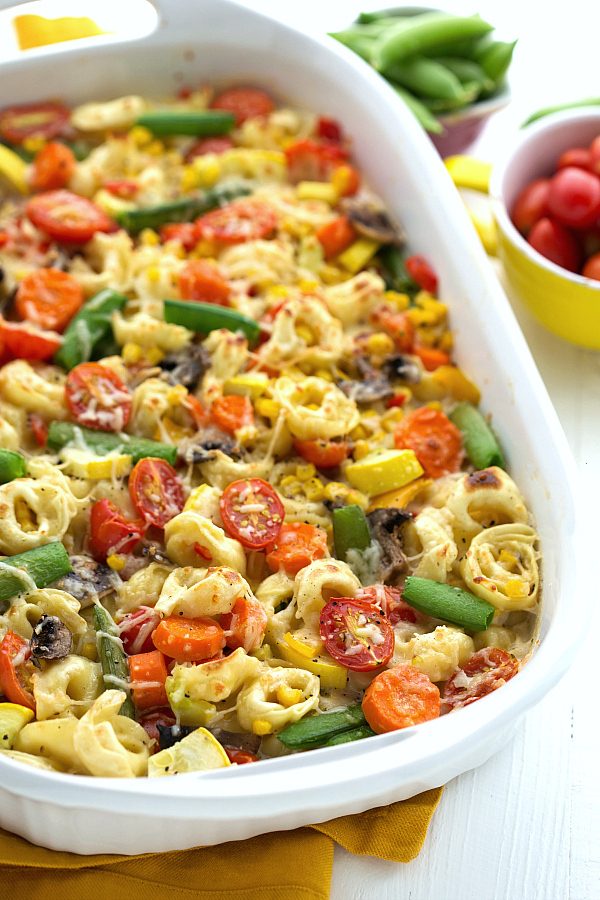
Cooking tortellini is one of the easiest things you can learn in the kitchen, and once you get the hang of it, you’ll always have a reliable dinner trick up your sleeve.
Whether you’re working with fresh tortellini from the refrigerated aisle or a frozen bag from Costco, the basic method stays the same: boil it in salted water. But the timing and texture can vary just a bit, so let’s walk through each version.
Step-by-Step for Perfectly Cooked Tortellini
- Bring a large pot of water to a boil.
Use at least 4 quarts of water for every 9-ounce package of tortellini. Add a generous tablespoon of kosher salt to the water. - Add the tortellini.
No need to thaw frozen tortellini, just drop it right in. Stir gently to keep it from sticking. - Watch for doneness.
- Fresh tortellini (like Buitoni or Rana) takes about 2 to 4 minutes.
- Frozen tortellini takes about 4 to 6 minutes.
It’s usually done when it floats to the top, but don’t just rely on that. Give one a quick bite. It should be tender but still hold its shape with no hard center.
- Drain and serve.
Use a slotted spoon or colander. If you’re tossing it straight into sauce, reserve a bit of pasta water to help everything cling together.
Do You Have to Thaw Frozen Tortellini Before Cooking?
Nope. That’s the beauty of frozen tortellini, it goes straight from freezer to boiling water. Thawing can actually make it more likely to break apart or get gummy in the pot.
How Do You Tell If Tortellini Is Cooked Through?
The float test is a good start, but texture is what really matters. A well-cooked tortellini should feel tender but springy when you bite into it. If it’s mushy or falling apart, it’s overdone. If the center feels firm or dry, give it another minute or two.
If your tortellini ever falls apart in the pot, chances are it was cooked too long or the water wasn’t at a rolling boil when you added it. I’ve been there, and thankfully, it only takes one or two tries to get the timing just right.
Avoid These 3 Common Mistakes When Cooking Tortellini
If your tortellini has ever turned out gummy, stuck together, or exploded in the pot, you’re not alone. I’ve made every one of these mistakes myself when I was first figuring it out. Once you know what to watch for, though, they’re easy to fix and your tortellini will turn out just right every time.
1. Overcrowding the Pot or Skipping the Salt
Tortellini needs space to move around in the water. If the pot is too small or packed too full, they’ll bump into each other, stick together, or cook unevenly. You also need to salt the water generously, like the sea. It’s your one chance to season the pasta itself before the sauce even touches it.
2. Not Stirring Right After You Add the Pasta
This is a big one. When you first drop tortellini into boiling water, the starches on the surface start to release. If you don’t give the pot a gentle stir in the first 30 seconds, you’ll end up with clumps of pasta fused together like a science experiment gone wrong. A wooden spoon and a quick swirl are all it takes.
3. Overcooking the Pasta Until It Bursts
Tortellini isn’t as tough as dry pasta. Overcooking it even by a minute or two can make it mushy, or worse, cause the seams to split and the filling to leak out. Always check a piece early, especially if you’re using a thinner variety like Rana tortellini.
What’s the Best Way to Keep Tortellini from Sticking Together?
Besides stirring at the start, make sure you’re using plenty of water, keep it boiling, and don’t crowd the pot. Some folks add a splash of olive oil, but I find that unnecessary if you stir properly.
Can You Cook Tortellini in the Microwave?
Technically yes, but I wouldn’t recommend it unless it’s part of a microwave-ready meal. Tortellini needs boiling water to cook evenly and keep its texture. The microwave can make it rubbery or inconsistent. If it’s your only option, heat water in a large microwave-safe bowl, add the tortellini, and cook in 1-minute intervals, stirring each time. But stovetop is always better.
One Base Recipe: Simple Cheese Tortellini with Butter, Garlic, and Parmesan
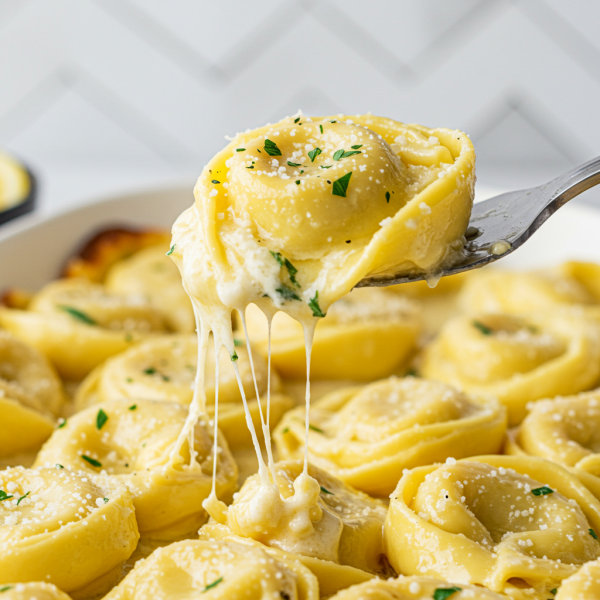
Once you’ve nailed the basics of how to cook tortellini, this is the recipe I recommend starting with. It’s simple, quick, and so full of flavor that no one will guess you used store-bought pasta. You can use any kind of tortellini here, Buitoni, Rana, frozen cheese tortellini from Costco, whatever you’ve got will work just fine.
I’ve made this recipe on weeknights when I’m running behind and also served it on the side of grilled chicken or steak for company. It’s cozy, buttery, and a great canvas for add-ins like spinach, sun-dried tomatoes, or crispy bacon.
Ingredients
- 1 (9-ounce) package cheese tortellini (fresh or frozen)
- 3 tablespoons unsalted butter
- 2 garlic cloves, minced
- ¼ teaspoon red pepper flakes (optional)
- ¼ cup grated Parmesan cheese (plus more for serving)
- Salt and freshly ground black pepper, to taste
- 1 tablespoon chopped parsley or basil (optional)
Instructions
- Cook the tortellini according to package directions until just tender. Drain, reserving ¼ cup of pasta water.
- Melt the butter in a large skillet over medium heat. Add the garlic and red pepper flakes and sauté for about 1 minute, just until fragrant. Don’t let the garlic brown.
- Add the cooked tortellini to the skillet and toss gently to coat. Stir in the Parmesan cheese and a splash of pasta water to help everything come together.
- Season with salt and pepper to taste. Sprinkle with fresh herbs if you’ve got them, and serve warm with extra Parmesan on top.
This easy base recipe tastes rich and fancy, but it comes together in under 20 minutes. Once you’ve got it down, you can start playing around with different flavors. Try adding halved cherry tomatoes, a little lemon zest, or some sautéed mushrooms to change things up.
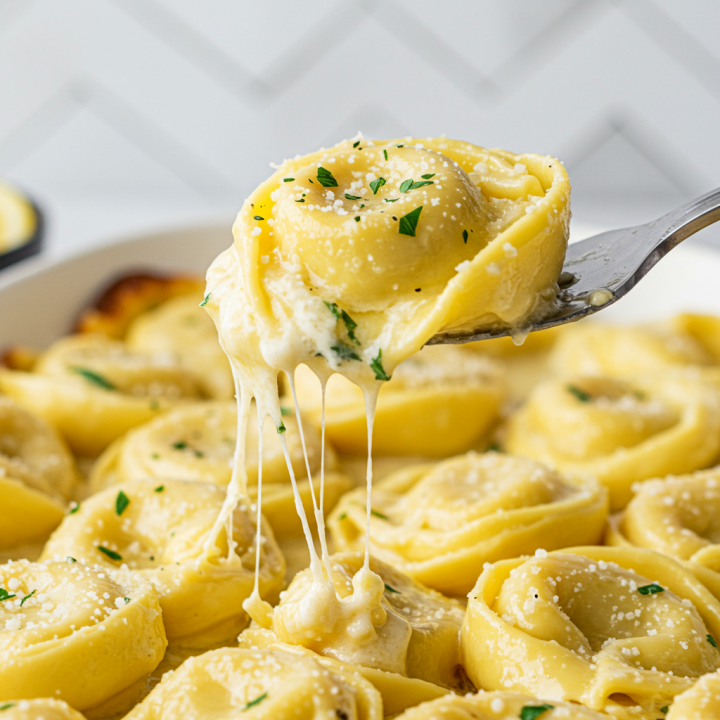
Simple Cheese Tortellini with Butter, Garlic, and Parmesan
This buttery, garlicky tortellini comes together in under 20 minutes and makes the perfect weeknight meal or side dish. It’s cozy, flavorful, and works with any store-bought tortellini, fresh, frozen, or refrigerated.
Ingredients
- 1 (9-ounce) package cheese tortellini (fresh or frozen)
- 3 tablespoons unsalted butter
- 2 garlic cloves, minced
- ¼ teaspoon red pepper flakes (optional)
- ¼ cup grated Parmesan cheese (plus more for serving)
- Salt and freshly ground black pepper, to taste
- 1 tablespoon chopped parsley or basil (optional)
Instructions
- Bring a large pot of salted water to a boil. Add the tortellini and cook according to package directions until just tender. Drain, reserving ¼ cup of pasta water.
- In a large skillet, melt the butter over medium heat. Add the garlic and red pepper flakes. Sauté for about 1 minute, just until fragrant. Don’t let the garlic brown.
- Add the cooked tortellini to the skillet and gently toss to coat in the butter. Stir in the Parmesan cheese and a splash of reserved pasta water to help the sauce come together.
- Season with salt and pepper to taste. Sprinkle with chopped parsley or basil if using. Serve warm with extra Parmesan on top.
Notes
Don’t overcook the tortellini. It should be tender but not mushy.
Add-ins like sautéed spinach, mushrooms, or halved cherry tomatoes are easy upgrades.
This dish pairs well with grilled chicken or a crisp green salad.
Can I Cook Tortellini in Sauce or Soup?
A lot of folks wonder if you can skip the boiling step and just toss tortellini into a pot of soup or simmer it right in a creamy sauce. The short answer is yes, but there’s a right way to do it if you want that pasta to stay plump and tasty instead of turning soggy or splitting open.
Cooking Tortellini in Sauce
If you’re using a thick sauce like Alfredo, marinara, or a creamy tomato blend, you’ll want to cook the tortellini separately first, then stir it into the sauce at the end. Why? Because tortellini needs fast, even cooking in boiling water. Most sauces aren’t hot enough or liquidy enough to cook it properly, and you’ll end up with chewy dough and half-cooked filling.
That said, once your tortellini is cooked, finishing it in the sauce for a minute or two with a splash of reserved pasta water is a great way to bring the whole dish together and coat every bite.
Cooking Tortellini in Soup
This method works beautifully, but you’ve got to time it right.
Whether you’re making chicken tortellini soup, Italian sausage tortellini soup, or a creamy spinach version, add the tortellini at the very end. Let it simmer gently in the broth for 4 to 6 minutes (less for fresh tortellini, more for frozen). If you add it too early, it’ll soak up too much liquid and start to fall apart before the soup is ready.
I’ve made this mistake with a big pot of soup before, and trust me, soggy tortellini ruins an otherwise perfect dinner. So just save it for the last few minutes, and you’ll be golden.
How to Make Store-Bought Tortellini Taste Homemade

Store-bought tortellini is a lifesaver on busy nights, but it can be a little bland or one-note if you just toss it with plain jarred sauce. The good news? It doesn’t take much to make it taste like you made the whole dish from scratch.
I’ve tested every shortcut under the sun, Rana, Buitoni, frozen Costco tortellini, and the secret is in what you add after cooking. A few fresh ingredients and pantry staples can take it from basic to downright craveable.
Add Flavor with Simple Upgrades
Here’s what I do when I want my tortellini to taste homemade:
- Sauté garlic in butter or olive oil before tossing the cooked tortellini in. It gives the whole dish a warm, rich base.
- Use fresh herbs like basil, parsley, or thyme. Even just a sprinkle makes a big difference in freshness.
- Add texture with toasted breadcrumbs or chopped nuts (pine nuts or walnuts are great on cheesy tortellini).
- Mix in vegetables like sautéed spinach, mushrooms, cherry tomatoes, or roasted red peppers. You’ll add color and balance the richness.
- Layer in flavor with a little lemon zest, a splash of cream, or a spoonful of pesto stirred into the sauce.
Bonus Tip: Finish in the Pan
After draining your cooked tortellini, try finishing it in the skillet with your sauce or butter mixture. Add a splash of the starchy pasta water and toss until the sauce thickens and clings to the pasta. That little step makes it taste like you worked harder than you did.
Even the most basic cheese tortellini can feel homemade with a few of these tricks. So next time you grab a pack of Buitoni or Rana from the fridge, don’t just heat and serve, dress it up, and your dinner guests will think you made it from scratch.
The Truth About Dried, Fresh, and Frozen Tortellini
Walk through any grocery store and you’ll spot tortellini in three different places: the dry pasta aisle, the refrigerated section, and the freezer case. If you’re wondering which one is best, the answer really depends on how you plan to use it and how much time you’ve got.
Let’s break down the pros and cons of each.
Fresh Tortellini (Refrigerated)
This is what you’ll find with brands like Buitoni and Rana, and it’s usually tucked near the deli or specialty cheese section. Fresh tortellini is soft, tender, and cooks in just 2 to 4 minutes.
- Pros: Fastest cooking, best texture, and the most flavor-packed fillings.
- Cons: Short shelf life. You’ll need to use it within a few days of opening the package.
I reach for fresh tortellini when I want something that feels a little fancier but still comes together quickly.
Frozen Tortellini
Costco’s giant bags of frozen cheese tortellini have saved dinner in my house more times than I can count. Frozen tortellini is flash-frozen at peak freshness, so the quality stays pretty high.
- Pros: Long shelf life, great for stocking up, and versatile in soups or baked dishes.
- Cons: Takes a couple minutes longer to cook. If overcooked, it can get soft or split open.
It’s perfect for tossing into soups or one-pot meals where convenience matters most.
Dried Tortellini
You’ll usually find this next to boxed spaghetti or penne. Dried tortellini has a much firmer texture and a long shelf life, often a year or more. It’s a little less common these days but still handy for pantry stocking.
- Pros: Longest shelf life and good for emergency meals.
- Cons: Longer cook time and usually less flavorful fillings compared to fresh or frozen options.
Dried tortellini works best when you’re making baked casseroles or heavily sauced dishes where it can soak up flavor during cooking.
Each type has its place in the kitchen, so don’t stress about picking the best one. I keep both frozen and fresh on hand, frozen for soups and backups, fresh for those buttery skillet dinners I know my family loves.
Bonus: 5 Delicious Recipes with Tortellini You Can Try Tonight
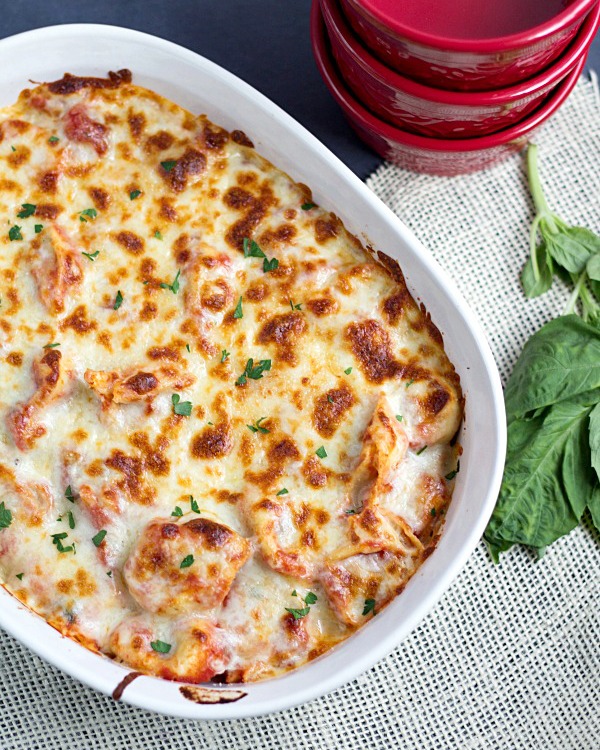
Once you’ve got the basics down, it’s time to put that tortellini to work in something fun. These are five of my go-to tortellini recipes, each one is packed with flavor, easy enough for a weeknight, and guaranteed to please a hungry crowd.
Whether you’re in the mood for something creamy, brothy, cheesy, or even a little spicy, there’s a recipe here you’ll want to save and make on repeat.
- Easy Italian Shrimp Tortellini Bake
This dish brings together shrimp, cheese tortellini, and a zesty tomato cream sauce for a warm, oven-baked dinner that feels a little bit fancy but couldn’t be easier. - Twenty Minute Easy Tortellini Bake
If you’ve got 20 minutes and a package of tortellini, you’ve got dinner. This recipe uses just a few pantry staples to make a cheesy, bubbly bake that’s perfect for busy nights. - Tortellini Meatball Soup
A hearty, flavorful soup that’s loaded with juicy meatballs, tender cheese tortellini, and plenty of veggies. It’s like Italian wedding soup’s cozier cousin. - Easy Chicken Enchilada Tortellini Bake
This one’s a fun twist, cheese tortellini meets the bold flavors of chicken enchiladas. It’s creamy, spicy, and packed with Tex-Mex comfort. - Creamy Sausage Tortellini Soup
A reader favorite for good reason. This soup has spicy sausage, tender cheese tortellini, and a velvety broth that’s rich without being heavy.
These are just a few ideas to get you started, but once you learn how flexible tortellini can be, you’ll start dreaming up your own versions too. I always say: if you’ve got a pack of tortellini in your fridge or freezer, you’ve got a meal waiting to happen.
Wrap-Up: You’re Officially a Tortellini Pro
By now, you’ve got everything you need to cook tortellini like a seasoned home chef. Whether you’re boiling it fresh, pulling it straight from the freezer, or stirring it into a bubbling pot of soup, you know how to get the timing right, how to avoid the mushy mistakes, and how to dress it up so it tastes like a homemade classic.
Tortellini is one of those ingredients that makes dinner easier without sacrificing comfort or flavor. And now that you’ve learned how to make it shine, plus how to troubleshoot every common hiccup, you’ve got a new weeknight staple to lean on again and again.
If you’ve got a favorite tortellini combo or a question I didn’t cover, I’d love to hear about it in the comments below. And if you try one of the recipes I linked above, let me know how it turned out! Your feedback always helps make this kitchen community even better.

Does the pasta need to be paper thin therefore on the thinnest setting which for me is no.7?